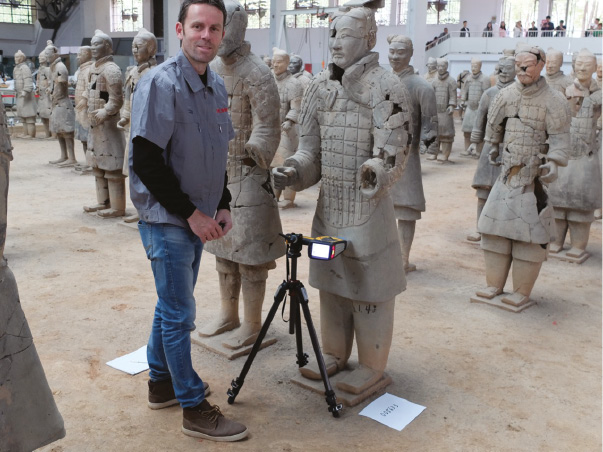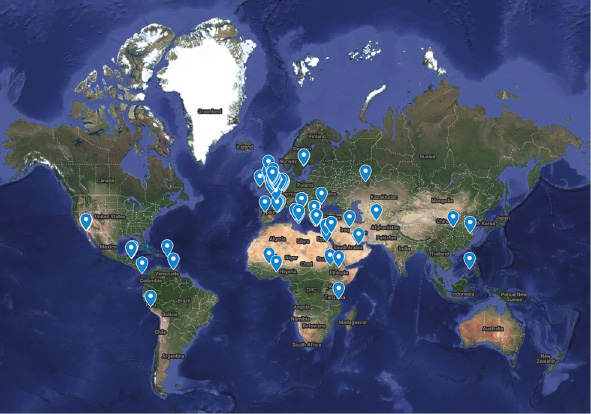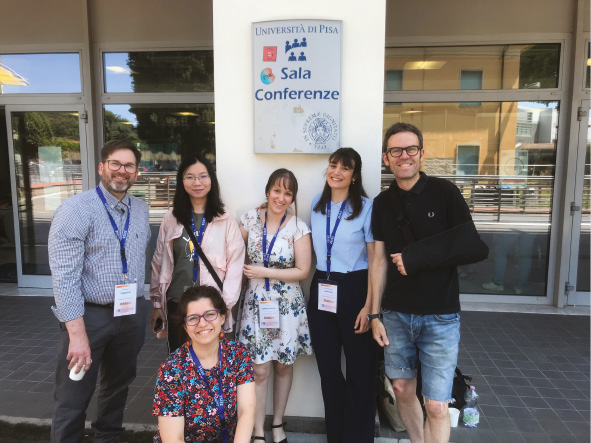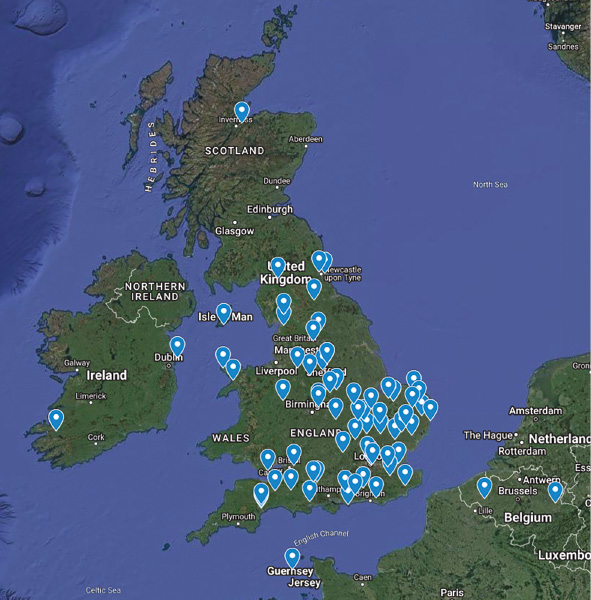The UCL Institute of Archaeology (IoA) has a long history of scientific research on ancient ceramics stretching back to the pioneering work of Henry Hodges (1962), which demonstrated the potential of approaches such as thin-section petrography before it was popularised. Hodges was aware of the technological information hidden within sherds, as well as the value of compositional data for the determination of provenance (Quinn 2013, 12). Many of his original slides are still held at the IoA, including those from his experimental studies into the processing of clay by past humans. The UCL thin-section collection also bears witness to occasional projects by staff and students during the late twentieth century. Despite some excellent work on refractories, archaeometric approaches to pottery fell out of favour at the IoA compared to the study of other inorganic artefacts, particularly metals, in which UCL was and still is, a leader. The appointment of Patrick Quinn in 2011, as a permanent member of the research staff focused on the scientific analysis of ceramics, sought to redress this situation by offering the kind of laboratory training, research supervision and commercial consultancy that he had established at his previous institution (University of Sheffield). Within a few years, the IoA was once more a globally recognised centre for ceramic analysis, and it has since continued to build a strong reputation in the field, including the publication of a key textbook on ceramic petrography (Quinn 2013) and a range of studies of some of the world’s most important ceramic collections, such as the Terracotta Army (Quinn et al. 2017, 2020) (Figure 1).
Patrick Quinn characterising the composition of statues of Emperor Qin Shihuang’s Terracotta Army, China, via non-destructive portable X-ray fluorescence spectroscopy. This research detected chemical differences that are indicative of the production of statues by two separate workshops working on the first emperor’s mausoleum (Quinn et al. 2020)
Today, the Institute has a vibrant ceramics research team with many PhDs and masters-level researchers, undergraduates and post-docs, who work under the umbrella of the IoA’s Archaeomaterials Research Network (AMRN).1 A wide range of ceramic wares from many archaeological periods and corners of the globe (Figure 2) are analysed scientifically at the IoA. Recent and ongoing PhD projects include pre-Hispanic Venezuela (Lozada-Mendieta 2019), Harappan period India (Ceccarelli et al. 2021), Iron Age Uganda (Page 2021), sixth-century ad China (Huang and Freestone 2017; Huang et al. 2020; Huang 2022), Ubaid Persian Gulf, Inka period Chile, Neolithic Greece and Bronze and Iron Age Jordan. Annually, masters and undergraduate dissertation projects deliver targeted analysis on equally diverse material, some of which is published (for example, Lewis et al. 2020; Sorresso and Quinn 2020; Ho and Quinn 2021; Barouda et al. 2023; Valancius et al. 2023). Such projects integrate a range of analytical methods, such as macroscopic and thin-section petrography, macro-trace analysis, instrumental geochemistry and scanning electron microscopy. These methods are used to compositionally characterise and classify pottery and other ceramic assemblages, interpret their raw materials and identify provenance and reconstruct aspects of manufacturing technology. This information is used to tackle a range of topics from trade and exchange, migration and cultural interaction, craft tradition and cultural identity, the organisation of production and cross craft interaction.
A recent highlight has been Maja Miše’s Marie Curie post-doc on trade and economy in the Hellenistic and Late Roman Adriatic (Miše and Quinn 2022). To compositionally link amphorae from both terrestrial sites and shipwrecks, it was possible to study the chemical alteration of the ceramic body in the sea, compared to land (Miše et al. 2021). Fineware production and circulation in the Dalmatian islands has also been studied as part of this project (Miše et al. 2020).
The IoA is very well equipped for a range of ceramics in terms of laboratories for the preparation of ceramic samples and their scientific analysis via the methods mentioned above. Much time and effort have been spent developing protocols for the non-destructive analysis of ceramics via portable X-ray fluorescence spectroscopy (pXRF) in order to apply this approach to the characterisation of complete statues of the Terracotta Army (Quinn et al. 2020), in one of the IoA’s flagship projects. The resulting bespoke ceramics calibrations have been applied widely to a range of other projects. More recently, the IoA’s Wolfson Labs,2 where the majority of ceramic research is carried out, have benefitted from the addition of laser ablation inductively coupled plasma mass spectrometry (LA-ICP-MS) to its arsenal. This equipment has been calibrated for ceramics research by Mike Charlton and is already being rolled out within projects to obtain geochemical data of high quality and sensitivity. Combined with scanning electron microscopy-energy-dispersive X-ray spectroscopy (SEM-EDS), X-ray diffraction (XRD), X-ray fluorescence spectroscopy (XRF) and mainstays such as thin section petrography, the IoA is unparalleled in the UK in terms of the equipment available for the scientific analysis of archaeological ceramics.
This array of approaches is at the disposal of students across the board, for PhD, MSc or undergraduate research. Hands-on lab training in ceramics and other inorganic materials is provided through the IoA’s long-running MSc in Archaeological Science: Technology and Materials.3 A dedicated module on Archaeological Ceramic Analysis (ARCL0102), coordinated by Patrick Quinn, gives students the theoretical background and laboratory skills to undertake their own research projects on ceramic analysis. The ceramic petrography handbook of Quinn (2013) has recently been superseded by a larger text that also covers instrumental geochemistry, SEM-EDS and related techniques (Quinn 2022a, 2022b). This both serves as a complete course book for ARCL0102 and a reference for MSc and PhD research at the IoA and beyond. Bill Sillar’s Interpreting Pottery masters module (ARCL0100) and Patrick Quinn’s undergraduate Archaeological Ceramics (ARCL0046) module provide training in the wider field of ceramics research, including the pottery life cycle or chaîne opératoire and ethnographic approaches. An intensive training course on Thin Section Petrography, Geochemistry and Scanning Electron Microscopy of Archaeological Ceramics4 for external participants, which takes place over the summer break is now in its thirteenth year and as popular as ever with ceramics researchers from other institutions and countries looking for specialist training.
The IoA has long-standing collaborations with other institutions for the purpose of research into ancient ceramics. These include the First Emperors Mausoleum Museum in China (Quinn et al. 2017, 2020), the Department of Anthropology, University of California San Diego (Burton et al. 2019, 2021), the Department of Archaeology, Aristotle University, Thessaloniki, Greece (Barouda et al. 2023) and the Competence Center Archaeometry Baden-Württemberg, Eberhard-Karls-Universitat, Tübingen (Amicone et al. 2019, 2020, 2021). The latter has seen students from the IoA and University of Tubingen visit each other’s labs to gain training or access to additional equipment. Closer to home, recent collaborations include Westminster Abbey and the UCL Centre for Digital Humanities. Two current ceramics researchers are funded through the PlaCe (Training the next generation of archaeological scientists: Interdisciplinary studies of pre-modern Plasters and Ceramics from the eastern Mediterranean) Marie Curie Innovative Training Network, a pan-European project that includes the IoA and is coordinated by ex-UCL ceramics PhD Maria Dikomitou from Cyprus Institute.
Patrick Quinn is the current president of the Ceramic Petrology Group, set up by the IoA’s Ian Freestone back in the mid-1980s (Quinn and Freestone 2018). This group has expanded internationally in recent years and hosts a popular annual meeting on scientific ceramics research, which in 2023 was held at the IoA. Our staff, post-docs and PhDs regularly present their ceramics research at key meetings such as the International Symposium on Archaeometry, the Society for American Archaeology, the European Association of Archaeologists and the European Meeting on Ancient Ceramics (Figure 3).
Beyond research and training, a successful commercial consultancy service5 has been running since 2011, providing thin-section petrography, geochemistry and SEM analyses on pottery, ceramic building material, refractories and plaster for a range of companies that include all the main archaeological firms in the UK (Figure 4), as well as overseas clients. The content of these scientific reports is often included in journal publications and books (for example, Flaherty et al. 2020; Roberts et al. 2020; Wells et al. 2020; Cotton et al. 2022; Daniel et al. 2021; de Bootman et al. 2021). UCL’s own commercial unit Archaeology South-East has also a strong ceramic specialism under the direction of Roman pottery expert Louise Rayner.
Location of commercial ceramics research consultancy carried out at UCL IoA (Source: www.ceramicpetroloogy.co.uk)
Declarations and conflicts of interest
Research ethics statement
Not applicable to this article.
Consent for publication statement
Not applicable to this article.
Conflicts of interest statement
The author declares no conflicts of interest with this article. All efforts to sufficiently anonymise the author during peer review of this article have been made. The author declares no further conflicts with this article.
Notes
References
Amicone, S, Quinn, PS; PS and Radivojević, M; M, Marić, M; M, Mirković-Marić, N N (eds.), . (2019). Tracing Pottery Making Recipes in the Balkans 6th–4th Millenium BC. Oxford: Archaeopress.
Amicone, SR; Radivojević, M; Quinn, PS; Berthold, C; Rehren, T. (2020). Pyrotechnological connections: Pottery firing technology and the origins of metallurgy in the Vinča culture, Serbia. Journal of Archaeological Science, : 118. DOI: http://dx.doi.org/10.1016/j.jas.2020.105123
Amicone, S; Radivojević, M; Quinn, PS; Rehren, T. (2021). Pottery technology at the dawn of metallurgy in the Vinča culture In: The Rise of Metallurgy in Eurasia: Early metallurgy and society in the Balkans. Radivojević, M, Roberts, BW; BW and Kuzmanović-Cvetković, M; M, Marić, M; M, Rehren, T T (eds.), : 538–551. Oxford: Archaeopress.
Barouda, A; Quinn, PS; Efstratiou, N. (2023). Agios Petros and the Neolithic pottery-making traditions of the deserted islands, Northern Sporades, Greece. Archaeological and Anthropological Sciences 15 : 16. DOI: http://dx.doi.org/10.1007/s12520-022-01713-0
de Bootman, M; Lyons, A; Quinn, P. (2021). Mortaria production at Pentney, in the Lower Nar Valley, West Norfolk. Journal of Roman Pottery Studies 18 : 1–16.
Burton, M; Quinn, PS; Bennallack, K; Farahani, A; Howland, MD; Najjar, M; Levy, TE. (2021). Ceramic technology at Wadi Fidan 61, an early pottery Neolithic site (ca. 6500 B.C.E.) in the Faynan region of Southern Jordan. Journal of Archaeological Science Reports 38 103029 DOI: http://dx.doi.org/10.1016/j.jasrep.2021.103029
Burton, M; Quinn, PS; Tamberino, A; Levy, T. (2019). Ceramic composition at Chalcolithic Shiqmim, northern Negev desert, Israel: Investigating technology and provenance using thin section petrography, instrumental geochemistry, and calcareous nannofossils. Levant 50 : 237–257, DOI: http://dx.doi.org/10.1080/00758914.2019.1625656
Ceccarelli, A; Quinn, PS; Singh, RN; Petrie, CA. (2021). Setting the wheels in motion: Re-examining ceramic forming techniques in Indus civilisation villages in Northwest India. Journal of Anthropological Archaeology, : 64. DOI: http://dx.doi.org/10.1016/j.jaa.2021.101346
Cotton, J; Daykin, A; Dunne, J; Quinn, PS. (2022). Early Neolithic pits at Principal Place, Shoreditch, London Borough of Hackney. Transactions of the London and Middlesex Archaeological Society 73 : 1–38.
Daniel, P; Andrews, P; Caffell, A; Challinor, D; Dunne, J; Evershed, RP; Gillard, T; Holst, M; Keefe, K; Leivers, M; López-Dóriga, I; Mepham, L; Petersone-Gordina, E; Quinn, PS. (2021). What are the dead for? Bronze Age burials in a multi-period landscape at Bucklow Hill, Cheshire. Archaeological Journal 179 (1) : 1–82, DOI: http://dx.doi.org/10.1080/00665983.2021.1921413
Flaherty, S; Wells, T; Andrews, P; Brook, E; Leivers, M; López-Dóriga, I; Quinn, PS. (2020). A ring ditch, Later Bronze Age pottery and Iron Age settlement at Seabrook Orchards, Topsham Road, Exeter. Proceedings of the Devon Archaeological Society, : 78.
Ho, JWI; Quinn, PS. (2021). Intentional clay-mixing in the production of traditional and ancient ceramics and its identification in thin section. Journal of Archaeological Science Reports 37 102945 DOI: http://dx.doi.org/10.1016/j.jasrep.2021.102945
Hodges, HWM. (1962). Thin sections of prehistoric pottery: An empirical study. Bulletin of the Institute of Archaeology 3 : 58–68.
Huang, S. (2022). The Origin of White Porcelain: Transformation of ceramic technology in sixth century North China.. Oxford: British Archaeological Reports International Series 3113.
Huang, S; Freestone, I. (2017). Developments in ceramic technology in North China in the sixth century AD. Archaeology International 20 : 64–68, DOI: http://dx.doi.org/10.5334/ai.355
Huang, S; Freestone, I; Zhu, Y; Shen, L. (2020). The introduction of celadon production in North China: Technological characteristics and diversity of the earliest wares. Journal of Archaeological Science 114 105057 DOI: http://dx.doi.org/10.1016/j.jas.2019.105057
Lewis, MP; Quinn, PS; Carter, R. (2020). Uruk expansion or integrated development? A petrographic and geochemical perspective from Gurga Chiya, Iraqi Kurdistan. Journal of Archaeological Science Reports 33 102516 DOI: http://dx.doi.org/10.1016/j.jasrep.2020.102516
Lozada Mendieta, N. (2019). Ancient Pots and Potters of the Atures Rapids Region: Occupation and interaction processes in pre-colonial Middle Orinoco, Venezuela. PhD dissertation. UCL.
Miše, M; Quinn, PS. (2022). Origins and distribution of Hellenistic and Late Republican transport amphorae in the Dalmatian region and its implications for Adriatic trade and economy. Archaeological and Anthropological Sciences 14 : 225. DOI: http://dx.doi.org/10.1007/s12520-022-01689-x
Miše, M; Quinn, PS; Glascock, MD. (2021). Lost at sea: Identifying the post-depositional alteration of amphorae in ancient shipwrecks. Journal of Archaeological Science 134 105463 DOI: http://dx.doi.org/10.1016/j.jas.2021.105463
Miše, M; Quinn, PS; Serneels, V; Charlton, M; Montanari, A. (2020). Production and circulation of Late Hellenistic fine table ware in Central Dalmatia, Croatia. Journal of Archaeological Science Reports 33 102537 DOI: http://dx.doi.org/10.1016/j.jasrep.2020.102537
Page, H. (2021). Technology, Function and Politics in the use of Ceramics: A case study from southern Uganda. PhD dissertation. UCL.
Quinn, PS. (2013). Ceramic Petrography: The interpretation of archaeological pottery & related artefacts in thin section. Oxford: Archaeopress.
Quinn, PS. (2022a). Thin Section Petrography, Geochemistry and Scanning Electron Microscopy of Archaeological Ceramics. Oxford: Archaeopress.
Quinn, PS. (2022b). Scientific investigation of museum objects: Planning, analysis, and wider impact In: The Handbook of Museum Archaeology. Stephenson, A (ed.), : 387–401. Oxford: Oxford University Press.
Quinn, PS; Freestone, I. (2018). A potted history of the Ceramic Petrology Group. The Old Potters Almanack 22 : 26–29, DOI: http://dx.doi.org/10.11588/opa.2017.1.43848
Quinn, PS; Ying, Y; Xia, Y; Li, X; Ma, S; Zhang, S; Wilke, D. (2020). Geochemical evidence for the manufacture, logistics and supply-chain management of Emperor Qin Shihuang’s Terracotta Army, China. Archaeometry 63 : 40–52, DOI: http://dx.doi.org/10.1111/arcm.12613
Quinn, PS; Zhang, S; Yin, X; Li, X. (2017). Building the Terracotta Army: Ceramic craft technology and organisation of production at Qin Shihuang’s Mausoleum Complex, China. Antiquity 91 : 966–979, DOI: http://dx.doi.org/10.15184/aqy.2017.126
Roberts, D; Barclay, A; Bishop, B; Bronk-Ramsey, C; Campbell, G; Canti, M; Dobie, J; Dunbar, E; Dunne, J; Evershed, R; Forward, A; Last, J; Lamb, S; Linford, N; Linford, P; Linscott, B; Madgwick, R; Marshall, R; Mays, S; McParland, H; Payne, A; Pelling, R; Pike, A; Price, K; Quinn, PS; Radini, A; Reimer, P; Russell, M; Seager Smith, R; Soutar, S; Speller, C; Vallender, J; Valdez-Tullett, A; van Heekeren, V; Worley, F. (2020). Middle Neolithic pits and a burial at West Amesbury, Wiltshire. The Archaeological Journal 177 : 167–213, DOI: http://dx.doi.org/10.1080/00665983.2020.1758495
Sorresso, DC; Quinn, PS. (2020). Re-examining shell-tempered Chickasaw pottery in post-contact Mississippi, USA. Journal of Archaeological Science Reports 32 102415
Valancius, M; Quinn, PS; Brass, M; Vella Gregory, I; Adam, A; Dunne, J; Evershed, RP. (2023). Production and use of ceramics in the first millennium BC: Jebel Moya, Sudan. African Archaeological Review, DOI: http://dx.doi.org/10.1007/s10437-023-09552-7
Wells, T; Newton, L; Andrews, P; Brook, E; Challinor, D; Harding, P; Higbee, L; Mepham, L; López-Dóriga, I; Quinn, PS. (2020). Bronze Age monuments and Iron Age settlement at Pinn Court Farm, Exeter. Proceedings of the Devon Archaeological Society, : 78.





